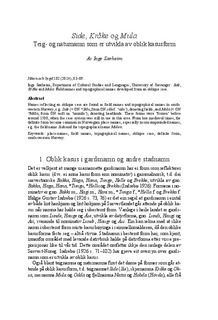Side, Kråke og Mula : Teig- og naturnamn som er utvikla av oblik kasusform
Journal article
Permanent lenke
http://hdl.handle.net/11250/2429015Utgivelsesdato
2014Metadata
Vis full innførselSamlinger
Originalversjon
Særheim, I. (2014) Side, Kråke og Mula : Teig- og naturnamn som er utvikla av oblik kasusform. Namn och bygd, 102 (2014), pp. 83–89.Sammendrag
Many farm names reflecting an oblique case in Old Norse are found in south-western Norway, e.g. Bakka (from ON Bakka, oblique case of ON bakki m. ‘hill, slope’) and Brekke (from ON Brekku, oblique case of ON brekka f. ‘steep slope’). Names reflecting an oblique case are also found among field names and topographical names; e.g. Side (ON *Síðu, oblique case of ON síða f. ‘side’), denoting fields beside brooks; Kråke (from ON *Kráku, oblique case of ON kráka f. ‘crow’), denoting rocks in the sea; and Mula (from ON *Múla, oblique case of ON múli m. ‘muzzle’), denoting headlands.
These forms were probably ʻfrozenʼ before around 1500 AD, when the case system was still in use in this area. In Old Norse, place-names were often used in the dative, owing to their frequent occurrence after a preposition describing position from or in a location. In late medieval times, the definite form became common in placenames, especially in uncompounded names, e.g. the field name Sida and topographical names like Kråka and Mulen.
Beskrivelse
Artikkelen har tidligere stått på trykk i tidsskriftet Namn och bygd, vol. 102, 2014, og gjengis her med tillatelse fra forlaget. Se http://www.kgaa.nu/tidskrift_ar.php?id=4&year=2014.
